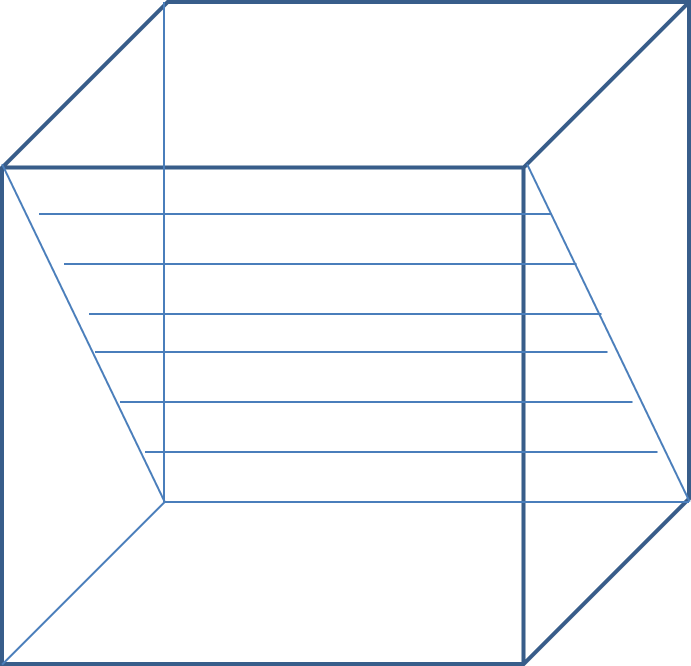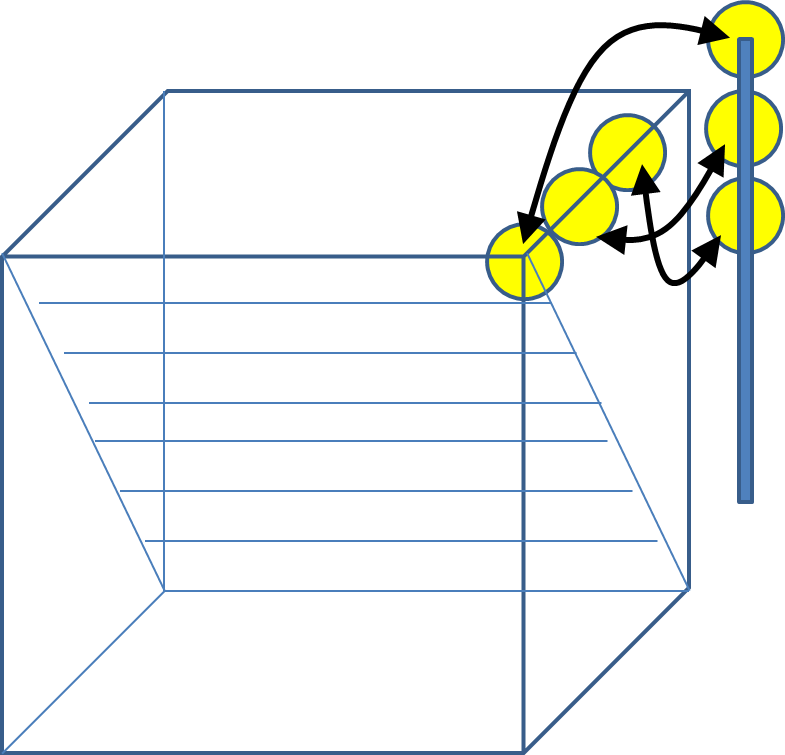Linear Algebra III
In this problem we will perform basic matrix calculus.
We begin by stating a few rules we will use. Everywhere the notation $x_i$ refers to the $i^{\rm th}$ component of a vector ${\mathbf x}$ and $x_{i,j}$ refers to the $(i,j)^{\rm th}$ component of a matrix ${\mathbf X}$.
- The derivative of a scalar $z$ with respect to an $N \times 1$ vector ${\mathbf x}$ is an $N \times 1$ vector. The $i^{\rm th}$ component of this vector is $\frac{dz}{dx_i}$.
- The derivative of a scalar $z$ with respect to an $N \times M$ matrix ${\mathbf X}$ is an $N \times M$ matrix, whose $(i,j)^{\rm th}$ component is $\frac{dz}{dx_{i,j}}$.
- The derivative of an $N \times 1$ vector ${\mathbf y}$ with respect to an $M \times 1$ vector ${\mathbf x}$ is an $N \times M$ matrix, whose $(i,j)^{\rm th}$ component is $\frac{dy_i}{dx_j}$.
Note the order of the indices in the following
- The derivative of an $N \times 1$ vector ${\mathbf y}$ with respect to an $M \times L$ matrix ${\mathbf X}$ is an $N \times L \times M$ tensor (note the reversal of the order of $L$ and $M$), whose $(i,j,k)^{\rm th}$ component is $\frac{dy_i}{dx_{k,j}}$ (again, note the reversal of the order of indices in the denominator -- to get the derivative in the $i,j,k$ location, we differentiate w.r.t to the variable in the $k,j$ location of ${\mathbf X}$.
- The derivative of an $N \times K$ matrix ${\mathbf Y}$ with respect to an $M \times L$ matrix ${\mathbf Y}$ is an $N \times K \times L \times M$ tensor, whose $(i,j,k,l)^{\rm th}$ component is $\frac{dy_{i,j}}{dx_{l,k}}$.
- The derivative of an $N_1 \times N_2 \times \cdots \times N_L$ tensor ${\mathbf Y}$ with respect to an $M_1\times M_2 \times \cdots \times M_K$ tensor is an $N_1 \times N_2 \times \cdots \times N_L \times M_K \times M_{K-1} \times \cdots \times M_1$ tensor.
The transpose of any $N_1 \times N_2$ matrix is an $N_2 \times N_1$ matrix. We will represent the transposition operation by the superscript $\top$. Let ${\mathbf Y} = {\mathbf X}^\top$. Then $y_{i,j} = x_{j,i}$ ({\em i.e.} the $(i,j)$-th component of ${\mathbf Y}$ is the $(j,i)$-th component of ${\mathbf X}$.
For the purposes of the computation here, we will expand the notion of transposes to tensors. Let ${\mathbf Y}$ be any $N_1 \times N_2 \times \cdots \times N_K$ tensor. By our definition ${\mathbf X} = {\mathbf Y}^\top$ is an $N_K \times N_{K-1} \times \cdots \times N_1$ tensor, whose components are given by $x_{i_1,i_2,\cdots,i_K} = y_{i_K,i_{K-1},\cdots,i_i}$.
Using the above definitions, we can also write the following chain rule.
- Let ${\mathbf X}$ be any matrix (noting that a vector is also a one-column matrix, so the same rule also applies to vectors, or tensors in general). Let $g(\bullet)$ and $h(\bullet)$ be two functions. The functions may have scalar, vector or tensor outputs. Let \[ y = g\left(h\left( {\mathbf X}\right)\right) \] Then \[ \frac{dy}{d{\mathbf X}} = \left(\frac{dh({\mathbf X})}{d{\mathbf X}}\right) ^{\top} \frac{d g}{dh} \] where $dg$ is shorthand for $d(g(h({\mathbf X})))$ and $dh$ stands for $d(h({\mathbf X}))$. Note the order of multplication.
- In general, if $f_1(\bullet)$, $f_2(\bullet)$, $f_3(\bullet) \cdots$ are functions, then if \[ y = f_1\left(f_2\left(f_3\left(\cdots f_K\left({\mathbf X}\right)\right)\right)\right) \] then \[ \frac{dy}{d{\mathbf X}} = \left(\frac{df_K({\mathbf X})}{d{\mathbf X}}\right)^\top \left( \frac{d f_{K-1}}{df_K}\right)^\top \left(\frac{d f_{K-2}}{df_{K-1}}\right)^\top \cdots \left(\frac{d f_2}{d f_1}\right)^\top \frac{d f_1}{df_2} \] Once again, note the order of computation.
- Let ${\mathbf X}$ be an $N \times M \times L$ tensor. It can only left multiply $L \times 1$ vectors. Let ${\mathbf y}$ be an $L \times 1$ vector. Then ${\mathbf Z} = {\mathbf Xy}$ is an $N\times M$ matrix whose components are given by \[ z_{i,j} = \sum_k x_{i,j,k}y_k \]
- Let ${\mathbf X}$ be an $N \times M \times L$ tensor. It can only left multiply $L \times M$ matrices. Let ${\mathbf Y}$ be an $L \times M$ matrix. Then ${\mathbf Z} = {\mathbf XY}$ is an $N\times 1$ vector whose components are given by \[ z_i = \sum_j\sum_k x_{i,j,k}y_{k,j} \]
A. Derivative of scalar function w.r.t. vector argument
Let ${\mathbf x}$ and ${\mathbf y}$ be $N\times 1$ vectors. Let \[ e = \| z - {\mathbf y}^\top{\mathbf x}\|^2 \] Show that \[ \frac{de}{d{\mathbf x}} = -2\left(z - {\mathbf y}^\top{\mathbf x}\right) {\mathbf y} \] The derivation is simple, based on rule number 1.B. Derivative of scalar function w.r.t. matrix argument
Let ${\mathbf X}$ be an $N\times M$ matrix, ${\mathbf z}$ be an $N \times 1$ vector, ${\mathbf y}$ be $M\times 1$ vectors. Let \[ e = \| {\mathbf z} - {\mathbf X}{\mathbf y}\|^2 \] Show that \[ \frac{de}{d{\mathbf X}} = -2\left({\mathbf z} - {\mathbf X}{\mathbf y}\right) {\mathbf y}^\top \]HINT:
For part B., the chain rule gives us: \[ \frac{de}{d{\mathbf X}} = \left(\frac{d{\mathbf X}{\mathbf y}}{d{\mathbf X}}\right)^\top \frac {d \| {\mathbf z} - {\mathbf X}{\mathbf y}\|^2} {d{\mathbf X}{\mathbf y}} \] Note that ${\mathbf X}{\mathbf y}$ is an $N \times 1$ vector whose $i^{\rm th}$ component is given by $\sum_j x_{i,j}y_j$. Therefore, representing ${\mathbf u} = {\mathbf X}{\mathbf y}$, \[ \frac {d u_i}{d x_{j,k}} = \begin{cases} y_k~~~~if~~j=i\\ 0~~~~~otherwise \end{cases} \] Thus, although $\frac{d{\mathbf u}}{\mathbf X}$ is an $N \times M \times N$ tensor, only the entries along the diagonal plane $i=j$ are non-zero, and all other terms are zero. That is, if we let ${\mathbf V} = \frac{d{\mathbf u}}{{\mathbf X}}$, using rule 4 we get \[ v_{i,k,j} = \begin{cases} y_k~~~~if~~i=j\\ 0~~~~~otherwise \end{cases} \] The resulting Tensor has the structure shown below. Only the diagonal plane shown in the figure has non-zero values. All the remaining values are 0. Each row in the diagonal plane is the vector ${\mathbf y}^\top$.
Because of the zero-valued off diagonal elements, tensor transposition has no effect on the tensor. Multiplying this tensor with any $M\times 1$ vector ${\mathbf t}$ has the following geometric interpretation. The figure below illustrates the operations.

Clearly, since only the diagonal elements have non-zero values, only one of the component-wise products has a non-zero value, and the sum takes this value.
This has the effect that for any $M \times 1$ vector ${\mathbf t}$, the matrix ${\mathbf S} = {\mathbf V}^\top{\mathbf t}$ is an $M \times N$ matrix whose components (according to rule 9) are given by \[ s_{k,j} = \sum_{i} v_{i,j,k}t_i = t_ky_j \] The indices can be verified by referring to the illustration above.